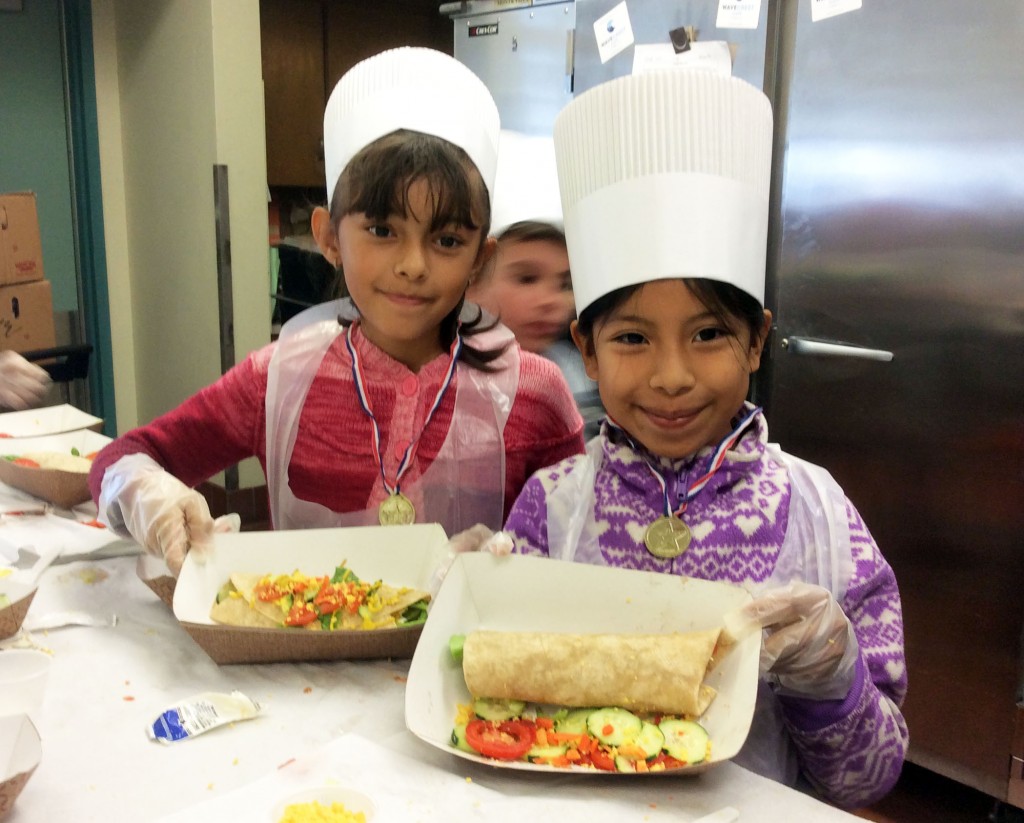
Culinary Arts and Creative Snack Creation at Monte Vista Elementary
September 14th, 2015
Recently, WaveCrest Café worked with Chef Alice Munoz-Aniya, from Le Cordon Bleu Academy, who visited Monte Vista Elementary School’s 4th grade class, taught by Carrie Svien. Chef Alice spoke with the class about careers in culinary arts, before leading them in an exercise to create an after school snack for themselves using a surprise batch of ingredients.
Students got creative with the ingredients and learned just how easy making a healthy snack can be. We spoke with Mrs. Svien, Monte Vista Principal Charlene Smith and WaveCrest Café Director Liz Connealy about the experience.
How did the event come about?
Charlene Smith: In supporting VUSD’s WavePact college preparedness initiative, Monte Vista is in the process of becoming a No Excuses School. One of the components of that is that each classroom adopts a university and the students learn all about the university throughout the year. I asked Liz (Connealy) if she would like to adopt a university and she chose Le Cordon Bleu. Liz planned the event with Chef Alice to expose the students to college and career options around the food industry.
What sort of ingredients did the kids get to make meals?
Carrie Svien: Groups of four were given a bucket. Some groups had Savory – carrots, tomatoes, lettuce, spinach, mustard, mayo, sharp cheddar, whole wheat tortilla. Other groups were given Sweet – cream cheese, Craisins, persimmons, whole wheat tortillas. Students created their own snack.
What sort of meals did they make?
Carrie Svien: We only had an hour and no cooking. So we talked about them making an after school snack on their own at home. They were able to pick ingredients from their bucket. Most folded it others rolled it into a burrito. A few teamed up with kids who had the ingredients from the other bucket and cut them in half to share so they got a taste of both.
What sort of responses did the kids have when they were presented with the idea of a culinary career?
Charlene Smith: There wasn’t a real opportunity for students to provide feedback to the options for culinary careers. The whole idea is pretty new to them, but they seemed interested especially when Alice was explaining all the career options.
Liz Connealy: The kids were excited to come into the kitchen and wear hats, aprons, and gloves. The kids today very familiar with culinary television shows like Cup Cake Wars and Top Chef, and I think it’s important that they have a range of ideas for college, and know what’s possible for them after high school, even at a early age.
Carrie Svien: When we returned to class we made a list of reasons to take a culinary class. It started with basics, like learning skills in your own kitchen, and moved to careers. The students were really focused on learning to use knives and to measure. We started talking about learning to combine ingredients so they taste good – this clicked. They were really excited to find out that some high schools have an entire class for culinary arts.
What do things like this bring to the education process?
Charlene Smith: We can educate students about a topic in the classroom, but events like this make the learning real. Learning becomes tangible and concrete. An opportunity like this connects students to real-life experiences. An additional benefit is that it exposed students to foods they might have not been exposed to otherwise.
Did any of the kids’ responses surprise you? If so, how?
Charlene Smith: The thing that surprised me the most was the care and creativity students put into creating their ‘meal.’ They were so excited and took great care as they created their masterpiece. You could really see the pride on their faces.
Carrie Svien: At first the kids were making faces at some of the ingredients. They were asking if they had to eat their creation. Once their creations were made and the tasting began even some of the reluctant students began eating. Six students wanted to save a portion of theirs to take home to show a parent they could make a snack (we packaged them up).
Liz Connealy: We had one student who wanted to garnish his plate. And I loved that he also said he wanted to be a chef. I was impressed how much they knew and how they paid attention.
What areas of education are integrated into an experience like this? Learning about wellness, careers, creativity, collaboration?
Charlene Smith: There were many areas of integration. Alice connected her presentation to our character education program and math. Another huge connection (and real-life application) came out of an idea the teacher had. She decided to have students create a Power Point presentation based upon Alice’s presentation that could be used if she ever does it again. Whenever students take their own learning and apply it to a new situation it solidifies the learning and increases the rigor substantially.
